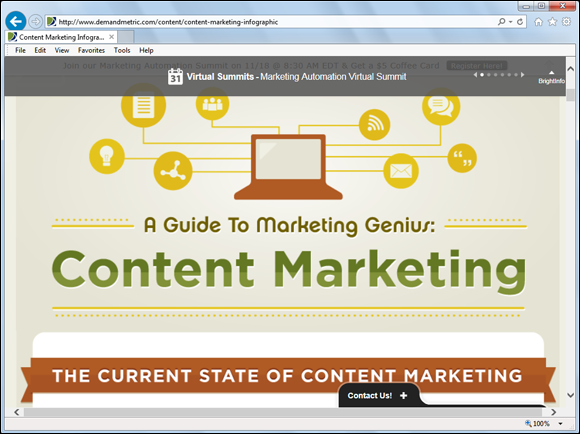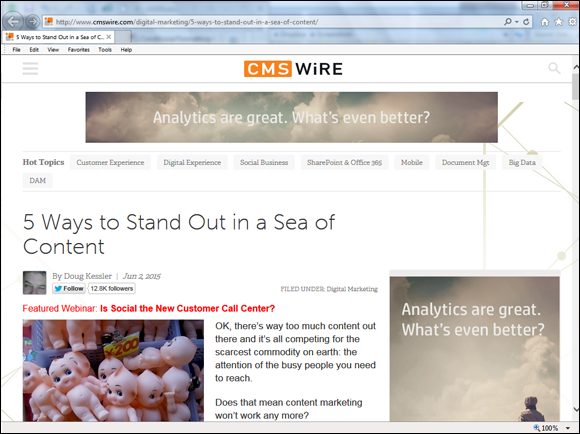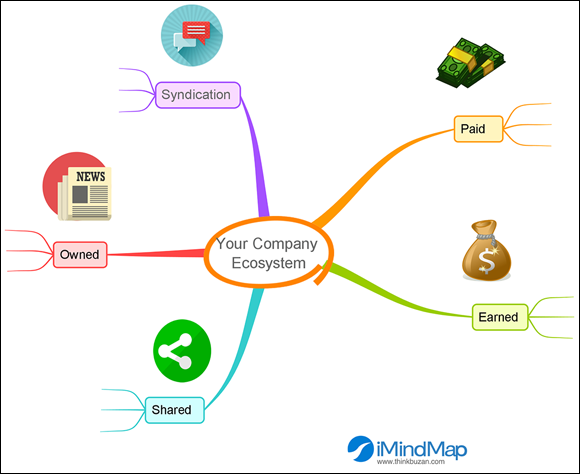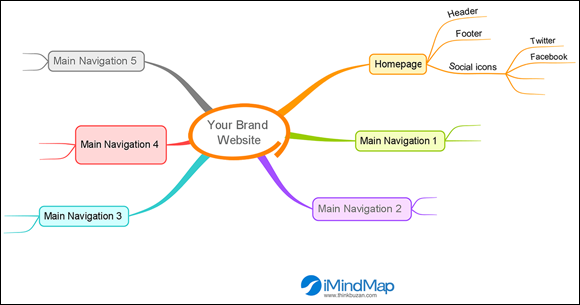Chapter 1
Creating Your Content Plan
IN THIS CHAPTER
 Knowing the value of your current content
Knowing the value of your current content
 Understanding the needs of stakeholders
Understanding the needs of stakeholders
 Identifying gaps in content
Identifying gaps in content
If you don’t have a content plan in 2019, you’re seriously jeopardizing your company’s chances for success. Everyone from “boring” companies like machinery manufacturers to red-hot companies like BuzzFeed have one.
As you begin creating your content plan, you need to remember that your content marketing strategy is different from your content plan. A content marketing strategy determines how your company goals will be met by marketing your content. A content plan details specifically how your content will be created, managed, and distributed to meet the goals you identified in your content marketing strategy.
In this chapter, you look at the current state of your content and what it takes to put a content plan together.
Evaluating Your Content
Your content can be one of your company’s greatest assets if you give it careful thought and attention. Some companies have been slow to get on the bandwagon, but they were quickly convinced when their competitors developed engaging content that attracted their customers.
If you’re wondering whether custom content matters to your customers, ask the Chief Marketing Officer Council World Wide (https://cmocouncil.org).
This organization’s research indicates that 78 percent of customers believe that companies that create custom content are interested in creating relationships with them. You engender goodwill by spending the time and money to create quality content.
Benefitting from a content plan
If your company has a digital marketing strategy, you may wonder if you need a content strategy as well. If you’re skeptical as to why you should create a content plan, take a look at some ways it can benefit you. When you have a cohesive content plan, you can
- Increase brand awareness and brand loyalty by being in the right place with quality content
- More effectively evaluate content performance and revise as necessary
- Save time and money and avoid duplicating efforts
- Meet customer needs during every part of the buyer’s journey
- Ensure that you deliver quality content that has been through an effective editorial process
- Deliver a consistent message on all your distribution channels
According to the infographic by Demand Metric, shown in Figure 1-1, “80 percent of people appreciate learning about a company through custom content and 60 percent are inspired to seek out a product after reading content about it.” You can find the infographic at http://www.demandmetric.com/content/content-marketing-infographic.

FIGURE 1-1: Demand Metric Infographic.
If you now grasp the value of having a content plan, you probably want to know how to make your content superior to that of your competitors. First off, the name of the game is quality, not quantity.
Doug Kessler, creative director and cofounder of Velocity Partners (http://www.velocitypartners.co.uk), outlined some interesting ways to get noticed in his article “5 Ways to Stand Out in a Sea of Content.” The article appeared in the CMS Wire blog, shown in Figure 1-2 and found at http://www.cmswire.com/digital-marketing/5-ways-to-stand-out-in-a-sea-of-content/.

FIGURE 1-2: CMS Wire.
Kessler suggests the following five tactics:
- Stay in your sweet spot. He defines your sweet spot as the overlap between your company’s knowledge and the things your customers care about. If you stay in that area, you’re sure to create quality content.
- Use psychographic targeting. Know what specifically resonates with your customers, and provide them with content that addresses their concerns.
- Harness emotion, not just the facts. As described in more detail in the later section called “Going viral” you’re most likely to get people to like and share your content when it evokes strong emotions.
- Practice insane honesty. This is an important concept. Kessler says that when you highlight your faults, people appreciate your honesty and are more likely to do business with you.
- Create confident content. This is content written by great writers who know their stuff and are convinced that what they have to share will be of value to you.
Also be sure to check out the Velocity Partners SlideShare called “Insane Honesty in Content Marketing” (http://www.slideshare.net/dougkessler/insane-honesty-in-content-marketing). It’s a great example of the idea behind the saying “Total honesty is the best ruse ever invented.”
Determining content maturity
Are you just getting started creating your content or is your company an old hand at it? Knowing where you stand is helpful when you begin creating your content plan. To determine your status, you can use a content maturity model. Todd Cameron has written an article about Kapost’s “The Content Operation Maturity Model,” shown in Figure 1-3 (http://marketeer.kapost.com/content-operation-maturity-model/#axzz). You can use it to assess where your company falls on the content maturity continuum between novice and practitioner.

FIGURE 1-3: The Kapost Content Operation Maturity Model.
Here are the status designations:
- Novice: This group is just getting started. Members may have siloed departments and don’t have an established process to create content.
- Practitioner: If you fall into this group, you’re starting to create processes and beginning to establish some visibility.
- Intermediate: This group is starting to establish a strategy and develop workflows.
- Advanced: If you’re in this group, you’re really moving forward. You are revenue focused and developing sound channel plans.
- Expert: This group has mastered content creation. You’re doing everything right. You’re optimizing your content and focusing on leads and revenue.
So where does your company fall on this continuum? Determine where you are now and what you need to do to get to the next level. Then let all the staff know your designation and what people can do as a team to move forward. This is a great way to motivate teams because they can see how collaboration will be rewarded.
Assessing Your Content
It’s time to look at your content so that you can learn what needs to be added or revised going forward. To assess your content, you need to do several things in the following order:
- Talk to your stakeholders
- Conduct a content audit and determine whether you have gaps in your content
- Create visual maps of key sites
The following sections consider each of these actions in turn.
Interviewing your stakeholders
Internal stakeholders play a very important role in your content plan. Their importance is often overlooked because listening to them takes time and effort. They are the keepers of important information and understand the history behind the content that’s been created.
One-on-one interviews are preferable, but you can do group interviews if you have very large groups of stakeholders.
Prepare interviewees by giving them the questions beforehand. You want them to be ready to give their perspective on the company’s content and procedures. Making the effort to speak to them will help you
- Find out about sites, landing pages, and other pages that were created and forgotten
- Understand why particular sets of content were created and how they performed
- Discover content needs that aren’t being met
- Learn about systems and procedures that are working well or need improvement
- Understand how internal stakeholders work together and what the challenges are in collaborating
- Get buy-in for your content plan when you have completed it
Conducting a content audit
Are you ready to conduct your content audit? It’s the step in the process that tells you exactly what content you have. If you work for a large enterprise, pockets of content may or may not have been documented. If you work in a small business, you may have a full audit or none at all.
The key to doing an effective content audit is deciding beforehand how comprehensive in scope you will get. You can determine the scope based on your specific goals, the volume of content, and the resources you have to accomplish the task.
Ask yourself the following questions to clarify your thinking:
- How do I define the goals of this project? Is this project being done for an imminent campaign or does it have to encompass all your content? Make sure that you can articulate the goals you have for each project.
- Are there specific priorities that I can apply? Based on what you’re trying to accomplish, can you limit your investigation to certain channels or types of content?
- Will it help me to know about every piece of content that exists? Decide how much depth you need to go to. Can you take a middle ground that collects representative content, or must it be all inclusive?
- How deeply should I go into the specifications for each piece of content? Do you want to take the time to document all characteristics for each piece of content? Do you want to know everything about a piece of content or can you be selective?
Now that you have determined the scope of your audit, look at what a content audit worksheet might include:
- Title: The exact title of the content piece. You may have several pieces with similar titles.
- Location: The URL where the content is located. It’s very important to note this location when doing the audit. Don’t duplicate efforts by requiring a producer to go and locate it every time it’s needed.
- Persona: The persona name for whom you created this content.
- Buyer’s journey step: The step in the buyer’s journey for which you created this content, such as “Consideration.” (See Book 2, Chapter 3 for more on the buyer journey.)
- Format: Describe the specific format the content is in. Is it an ebook, a blog post, something else? This information will help you determine how you can repurpose it.
- Topic/keywords: Put in the known keywords that were used and, if possible, the specific topic under which this content was categorized.
- Call to action (CTA): Identify the CTA for the content piece. Knowing the CTA is very useful when you’re determining a content sequence, such as a link to a landing page.
- Metrics: List any metrics you have that let you know how well the content performed.
As mentioned previously, you might not choose to include all the preceding items. Modify your worksheet based on the type of content audit you’re doing. You also have to determine whether you can collect some of the items in a reasonable amount of time.
Visualizing Your Sites
When planning your content, consider visually mapping it to see the big picture. One way to do this is to create a map of your content ecosystem.
Mapping your content ecosystem
Your content ecosystem shows how your content fits together. Your map can be as detailed as you like. You can document every site, social media account, and landing page you have, or you can list only the most important ones. It’s up to you. The goal is to create an easy way to see how and where your content is distributed.
To create this kind of map, you can reference the PESO model in Book 5, Chapter 1. An example of this kind of mind map template is shown in Figure 1-4.

FIGURE 1-4: Suggested mind map for documenting your ecosystem.
As you can see in the figure, you can document your ecosystem by category:
- Owned media: List all your branded sites, including your website, blog, micro sites, and user-generated content (UGC).
- Shared media: Include your social platform accounts and any places you guest post, embed infographics, or upload slide shows.
- Paid media: Here you list media that you pay for, such as Facebook Ads and traditional and native advertising.
- Earned media: Examples of earned media are influencer reviews, traditional PR, and media relations.
- Syndication: Add sites in this category if you’re distributing your site via syndication.
A map of your content ecosystem helps you see the big picture of your content distribution. If you keep this updated, it can be a valuable tool for you and your team.
Picturing website content
Another map that you should consider creating is one of your website’s and or blog’s home page content and subpages. It serves several important content-related purposes.
Mapping your website in this way helps you do the following:
- See exactly what content your company thinks is important. By seeing what content is displayed on the main pages, you instantly see the content that is highlighted. You can then ask stakeholders whether they believe it reflects current business goals.
- Compare maps of competitor websites. You can create and compare maps of your competitors’ sites to see how your content presentation differs from theirs and whether you need to make revisions.
- Learn about content that is buried. You will see content that is not featured and should be brought up to a higher level on the site.
- Determine whether there is content you should immediately create or repurpose. Seeing what’s featured will show you where your gaps are and how they can be remedied.
- Use the map to determine whether a redesign is needed. Mapping website content almost always ignites a conversation about whether you’re focusing on current business goals. You may choose not to do a redesign immediately, but you may want to budget for one in the future.
- Use the map to get changes made to content navigation. When you look at navigation, you may find that your priorities have changed and a revision would be useful.
As you can see, mapping your website and other important sites can facilitate a lot of discussion and insights. Figure 1-5 shows an example of a map template that you can use as a model.

FIGURE 1-5: Model of a website map.
Creating Your Plan
It’s time to create your content plan. In Table 1-1, you see the components that go into developing it.
TABLE 1-1 Components of Content Strategy
|
Component |
Why It’s Needed |
How to Prepare |
|
Stakeholders |
To ensure that you have information from all those who can make or break the project |
Conduct one-on-one interviews. Hold group meetings. |
|
Content audit |
To determine existing content |
Do a content audit. |
|
Personas |
To know who is the target of your content |
Use the information about personas in Book 2, Chapter 2. |
|
Buyer journey |
To know what the customer needs to see on his journey to buy |
Use the information about the buyer journey in Book 2, Chapter 3. |
|
Story |
To create a context for your prospect’s choice and establish your “why” |
Use the information you develop from the section “Crafting the story” in Book 3, Chapter 4. |
|
Governance, systems, and editorial calendar |
To determine how content is judged, assigned, and moved through to completion |
See Book 3, Chapter 5 for more on this topic. |
|
Metrics |
To be able to determine metrics that tie to your KPIs |
Choose metrics (see the bullet about key success metrics in the list that follows). |
The following list describes how each of the components in Table 1-1 helps you determine what goes in your content plan:
- The business case for content: If you created your content marketing strategy), you have made a business case for your content. Use the business case you created (or will create) for your content to inform your plan.
- Stakeholder interviews: Your stakeholders will provide you with a wealth of knowledge and insights about what has been done and why. Using this knowledge will ensure that your content plan with be better defined and executed.
- A completed content audit: After you have completed your content audit you will know what content you currently have and what you need to create going forward. Obviously, this is crucial to your plan’s success.
- Defined personas for your market niche: Your personas will tell you who you’re targeting with your content. If you don’t have personas you won’t be able to create content that resonates with your customers. It will be generic content that won’t engage anyone to pay attention to you. (See Book 2, Chapter 2 for more about personas.)
- A map of your buyer journey: By determining your touchpoints along the customer journey you can now see the content you need for each stage and persona. (See Book 2, Chapter 3 for more about the buyer journey.)
- Your business story: Obviously, your business story will determine the themes you choose to write about. Storytelling is a key way to engage your prospects.
- Key success metrics: Choosing your success metrics is a very important part of your content plan. They will tie back to the key performance indicators (KPIs) that you determined were important when you developed your digital marketing strategy. (See Book 1, Chapter 1 for suggested metrics.)
With this information, you can begin to outline your content using a content plan worksheet. Note that you should complete a separate sheet for each persona.
Focusing on Specialized Content
Before you leave the topic of content planning, you should know about several kinds of content that should be on your radar screen. These include pillar content, evergreen content, visual content, and viral content. Read on to see why you should keep them in mind when developing your content plan.
Creating pillar content
Do you know what pillar content is? You’re probably using it even if you don’t know the term. Pillar content is quality foundational content that you create to represent your brand. This content can be ebooks, tutorials, or other substantial content pieces that provide value.
From this content, you create a variety of other pieces of content that function as a pillar “supporting” a topic. This means that you can take the tutorial you created and turn it into a
- Video
- Podcast
- Mind map
- Google Hangout
- Guest post
- Webinar
You really have no limit to the amount of pillar content you can create.
Utilizing evergreen content
Evergreen is an important concept that you should consider when you’re creating content. Evergreen content is content that can be enjoyed without regard to when it was created. For example, a blog post about “how to be a productive entrepreneur” can be read any time of the year in any recent year. It’s timeless and can keep readers interested whenever they come upon it.
Some examples of evergreen content include:
- Tutorials
- Support content and FAQs
- Ebooks
- Online tools lists
- Favorite resources
- Company stories
So what should you keep in mind when creating this type of content? You should
- Make it easy to consume: Visitors appreciate content that doesn’t take a long time to read and isn’t overly complex.
- Create only high-quality assets: If the content is going to be around for a while and represent your brand, you want to ensure that it can delight and engage customers.
- Include visuals: Visuals are key to creating great content. Make sure that all evergreen content has graphics, photos, and so on.
- Create a series: It’s helpful to create evergreen content that is in series form. Readers look for the other articles in a series after they find one of them.
An interesting article by Julia McCoy, CEO of Express Writers called “Why You Need to Start Creating Long, Evergreen Content Today” was published in the Search Engine Journal.
In the article, she discusses why small business owners specifically benefit from long evergreen content. She lists several reasons that could also apply to any size business:
- Google rewards more in-depth content, and places you higher in search results.
- Your visitors appreciate content that is not overly complex but is instructive and useful.
- You can get leads over a sustained period of time with less effort.
- Evergreen content keeps you relevant and provides quality content whenever visitors find it.
Using graphics and other visuals
Throughout this book, you see how visuals enhance your content marketing efforts. To emphasize that point, here are just a few stats that show how using visuals powers up your content:
- When you include an image with a tweet, you get 18 percent more clicks than those without images, and you get 150 percent more retweets (Buffer).
- Eighty-six percent of buyers want interactive/visual content on demand (Demand Gen Report).
Your customers respond to visuals, and taking advantage of this responsiveness is imperative. A wide variety of choices are available to you, such as infographics, memes, comics, doodles, sketches, photos, wireframes, custom graphics, and more.
Going viral
What about viral content? Everybody wants to create it, but do you really know how? Some research done by Jonah Berger and Katherine L. Milkman suggests some of the components that make up viral content.
Berger and Milkman published an article in the Journal of Marketing Research called, “What Makes Online Content Viral?” (To download the PDF, use this link: https://marketing.wharton.upenn.edu/files/?whdmsaction=public:main.file&fileID=3461.) They analyzed New York Times articles and determined that emotion played a large part in creating sharing behavior.
Specifically, they found that:
- Positive content is more likely to go viral than negative content.
- High psychological arousal fuels viral content. Content that evoked such strong emotions as awe, anger, anxiety, and sadness was more likely to go viral than weaker emotions.
This research can help you when you’re creating content with an eye toward going viral, but it can’t ensure your success. One sure-fire way to get some power from viral content is not to write it, but to curate it.
After you know that a piece of content has gone viral you can ride its coattails by creating an article that uses the viral content in it. You may not get a huge reaction, but at least you know that people will be interested in viewing and sharing it.
 You can see that you will miss important insights if you avoid talking to all your stakeholders. Jump in and get it done. Your stakeholders will appreciate being consulted.
You can see that you will miss important insights if you avoid talking to all your stakeholders. Jump in and get it done. Your stakeholders will appreciate being consulted. It’s important to do a content audit to help you determine the gaps in your content. You do this when you’re putting your content plan together.
It’s important to do a content audit to help you determine the gaps in your content. You do this when you’re putting your content plan together.